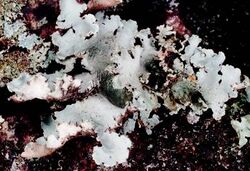Biology:Parmotrema
| Parmotrema | |
|---|---|

| |
| Parmotrema hypotropum | |
| Scientific classification | |
| Domain: | Eukaryota |
| Kingdom: | Fungi |
| Division: | Ascomycota |
| Class: | Lecanoromycetes |
| Order: | Lecanorales |
| Family: | Parmeliaceae |
| Genus: | Parmotrema A.Massal. (1860) |
| Type species | |
| Parmotrema perforatum (Wulfen) A.Massal. (1860)
| |
| Synonyms | |
| |
Parmotrema is a genus of lichen belonging to the family Parmeliaceae.[1] It is a large genus, containing an estimated 300 species,[2] with a centre of diversity in subtropical regions of South America and the Pacific Islands.[3]
Members of the genus are commonly called ruffle lichens or scatter-rag lichens.[4]:83
Description
Parmotrema is characterized by its typically large, moderately to loosely-attached foliose thallus with broad lobes that are usually more than 5 mm wide. There is a broad, naked zone around the margin of the lower surface, an epicortex with pores and an upper cortex with a palisade-plectenchymatous arrangement of hyphae. Ascospores are thick-walled and ellipsoid.[5]
Taxonomy
The genus was proposed as a genus by Italian lichenologist Abramo Bartolommeo Massalongo in 1860, with Parmotrema perforatum as the type species.[6] The genus name, composed of the Greek parmos (cup) and trema (perforation), refers to the perforate apothecia. Parmotrema was largely ignored as a genus,[7] and its species were usually grouped in section Amphigymnia of the large genus Parmelia.[8] Several genera previously segregated from Parmotrema have since been folded back in owing to molecular phylogenetic evidence, including Canomaculina, Concamerella, Parmelaria, and Rimelia.[3][9]
Gallery
See also
References
- ↑ Lumbsch TH, Huhndorf SM. (December 2007). "Outline of Ascomycota – 2007". Myconet (Chicago, USA: The Field Museum, Department of Botany) 13: 1–58. Archived from the original on March 18, 2009. https://web.archive.org/web/20090318003134/http://www.fieldmuseum.org/myconet/outline.asp.
- ↑ Lücking, Robert; Hodkinson, Brendan P.; Leavitt, Steven D. (2017). "The 2016 classification of lichenized fungi in the Ascomycota and Basidiomycota–Approaching one thousand genera". The Bryologist 119 (4): 361–416. doi:10.1639/0007-2745-119.4.361.
- ↑ 3.0 3.1 Blanco, Oscar; Crespo, A.; Divakar, Pradeep K.; Elix, John A.; Lumbsch, H. Thorsten (2005). "Molecular phylogeny of parmotremoid lichens (Ascomycota, Parmeliaceae)". Mycologia 97 (1): 150–159. doi:10.1080/15572536.2006.11832848. PMID 16389966.
- ↑ Field Guide to California Lichens, Stephen Sharnoff, Yale University Press, 2014, ISBN:978-0-300-19500-2
- ↑ Kurokawa, Syo; Lai, Ming-Jou (2001). "Parmelioid lichen genera and species in Taiwan". Mycotaxon 77: 225–284. http://www.cybertruffle.org.uk/cyberliber/59575/0077/0260.htm.
- ↑ Massalongo AB. (1860). "Esame comparativo di alcune genere di licheni" (in Italian). Atti dell'Istituto Veneto Scienze. 3 5: 247–276.
- ↑ Spielmann, Adriano Afonso; Marcelli, Marcelo Pinto (2009). "Parmotrema s.l. (Parmeliaceae, lichenized Ascomycota) from Serra Geral slopes in central Rio Grande do Sul state, Brazil". Hoehnea 36 (4): 551–595. doi:10.1590/S2236-89062009000400002.
- ↑ Hale, Mason E. (1974). "New combinations in the lichen genus Parmotrema Massalongo.". Phytologia 28 (4): 334–339. https://www.biodiversitylibrary.org/page/13046332#page/348/mode/1up.
- ↑ Crespo, A.; Kauff, F.; Divakar, P.K.; Prado, R. del; Pérez-Ortega, S.; Paz, G.A. de; Ferencova, Z.; Blanco, O. et al. (2010). "Phylogenetic generic classification of parmelioid lichens (Parmeliaceae, Ascomycota) based on molecular, morphological and chemical evidence". Taxon 59 (6): 1735–1753. doi:10.1002/tax.596008.
Wikidata ☰ Q10620680 entry
 |



